Tapestry – playing through the history
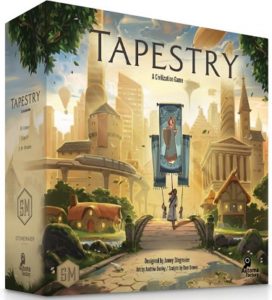 The buildings in our capital are growing higher and higher. With the new buildings we show who we are. We are the entertainers, we bring entertainment to the world and other cultures need us. But it was a long way until we had achieved this. It all started with our little huts, on a small hill in the middle of a pristine forest. But over the decades not only our capital city grew, but also the country that made up our nation. And with the land grew our knowledge, our history and our culture. So now we are about to take the next step, we will leave this planet and continue our journey to the stars.
The buildings in our capital are growing higher and higher. With the new buildings we show who we are. We are the entertainers, we bring entertainment to the world and other cultures need us. But it was a long way until we had achieved this. It all started with our little huts, on a small hill in the middle of a pristine forest. But over the decades not only our capital city grew, but also the country that made up our nation. And with the land grew our knowledge, our history and our culture. So now we are about to take the next step, we will leave this planet and continue our journey to the stars.
Tapestry is the name of the new board game by Jamey Stegmaier, which already caused a lot of conversation in the forefield. When it was delivered, opinions about Tapestry were divided. Now that some time has passed, we have written our opinion about Tapestry. What we think about the board game, which is also published in Germany by Feuerland Spiele, you can read in our review below.
The Tapestry Hype
In short, I can say this about Tapestry: I like Tapestry. And I think Tapestry is quite good for what it is. For me the board game is a typical Stonemaier game again. And that’s exactly what I expected when I placed the pre-order for the game.
But apparently Tapestry was put on a pedestal before the first delivery, which only made sure that the game couldn’t live up to these expectations. It was supposed to be the ultimate civilization board game, but as fast and easy to access as a Wingspan. It was only a matter of time before the first mixed reviews started coming in, and with each review I wondered if it was the right decision to buy this game.
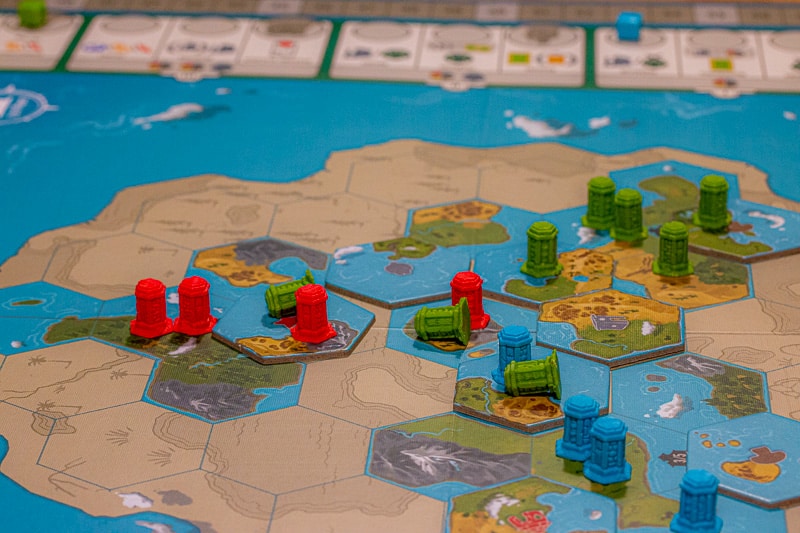
But the grumbling in the stomach was unnecessary. Tapestry quickly turned out to be a quite good board game for me. Sure, it has its little mistakes, which I will go into later, but on the whole I am satisfied with the overall package. And it fits my expectations of a Stonemaier game like a glove. For me, these are games that are relatively simple and accessible, have a good amount of lucky elements, have a high production quality and still have enough depth to go beyond a first game. Perhaps they also encourage a certain amount of controversy or discourse in the board game bubble at the same time, but that would only be the icing on the cake.
Well and looking back at the games of Stonemaier Games, it all fits the latest board game releases including Tapestry.
Tapestry in detail
If I take a closer look at Tapestry, I notice after just one game that the board game is not really a civilization game. I search in vain for what actually constitutes a CIV game (a solid technology tree), just as I search in vain for spreading and settling on the game board. Especially these concepts are very rudimentary and broken down. Or as they say now very currently: very strongly streamlined or simplified.
I can explore technologies in the course of the game, but they are not bound to a technology tree. So it may be that I research the lithium battery first and before the end of the game I research the paper. The bottom line is that new technologies only bring me more victory points or resources. There is no real play advantage that might affect my research or my military.
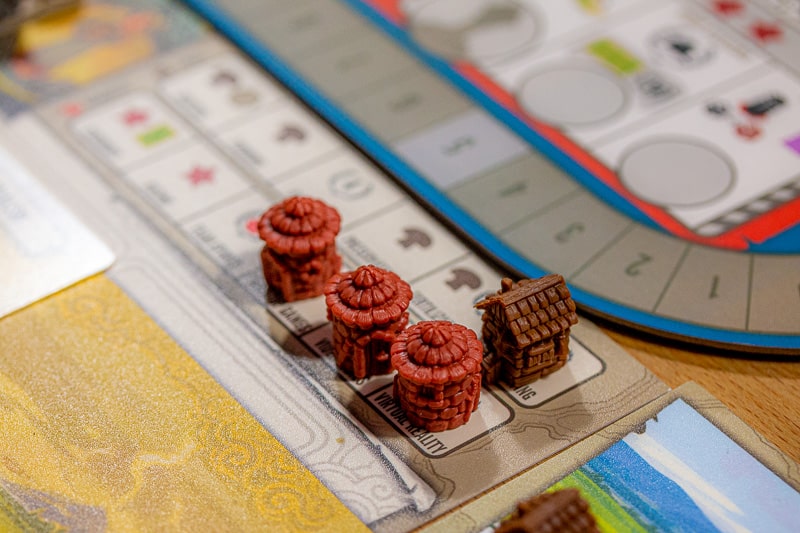
However, the military does not need an advantage either, because the military is de facto non-existent. If I want to conquer an area, I simply place one of my outposts, roll two dice, choose one of the two results as a reward and the conquest is complete. If by chance an outpost of another player is already present, then I automatically win, unless the other player conjures a trap card from his hand. This makes for a fast game, but not a CIV feeling, which is about commanding troops and, depending on the game, being an aggressor or defending your lands.
Probably Tapestry would have done better if it hadn’t called it “A Civilization Game“, because this addition simply appeals to a different player community. There are other board games here that simply put this theme more playfully into practice.
Personally, I think that hardly any board game manages to create exactly the CIV feeling I have when I play the digital counterparts. Be it Sid Meier’s Civilization or the complex Europa Universalis IV, where the PC simply has more possibilities than the board game. Even the complex Through the Ages or Nations are still missing the final touches, but they are already quite close. If I follow the argumentation of a game author at SPIEL’19, random elements have no place in a CIV game. And there are quite a few random or lucky elements in Tapestry.
Rules in lean
Tapestry is quite easy and pleasant to play, because I can only choose two possible actions during my turn: Either I generate income or I move forward on one of the four advancement tracks.
On the Income Turn, I get new resources, new cards, can upgrade a technology, and what matters at the end of the day is generating victory points. In the end, the winner is the player at the table who has the most victory points after 5 rounds.
And even if at first glance it looks like a race, it is not at all. How fast you roam through the “ages” of history is actually secondary. So it can happen that player one is already done with the entire game, while player two is just starting the final round. In this case, you just have to wait for the first player and maybe hope for passive victory points.
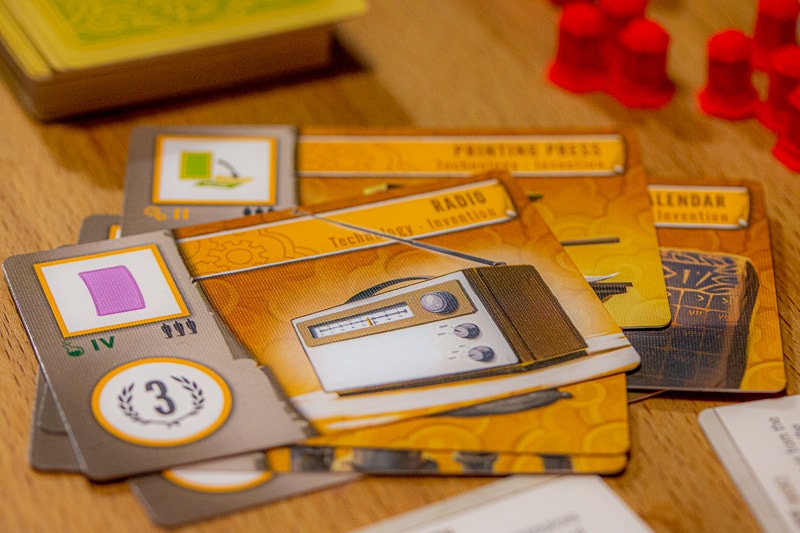
If I decide to make an Advance Turn, i.e. a further step on one of the progress bars, I pay a certain number of resources to move my marker forward, depending on the square. On the new square I then do the corresponding action that thematically matches the progress bar.
In the military field, this usually means conquering new territories. As you move along the exploration track, you will be able to draw hidden landscape tiles and place them on the map.
The Science Track is a bit of a supporter. First and foremost it helps you to get ahead on the other tracks. This is especially helpful if you lack the appropriate resource, provided you are lucky with the dice. Most of the time it is the science dice and their results that decide where you can advance.
The last of the possible ledges is the technology track. This is about getting technology cards and of course upgrading them, in addition to the one upgrade I have during the income phase.
Even though it is pleasing that the rules fit on slim four pages, in my opinion this is a bit too little. The one or other example for clarification would have done the rules good again. We could not do without asking BGG after all.
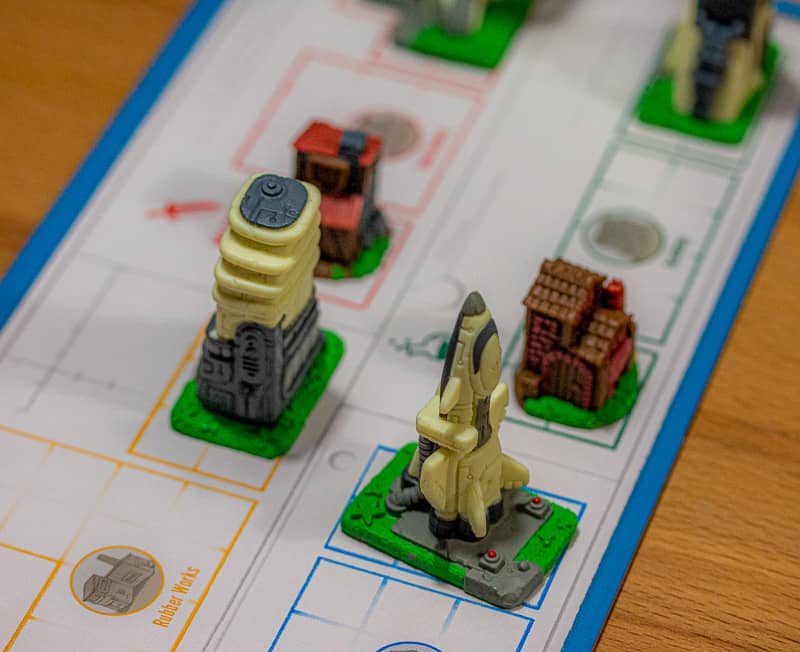
Tapestry is quickly learned but also quickly played?
The simple mechanics I then also internalized quite fast. And so a turn goes fast, because I can plan everything in advance. Unless somebody snatches one of the buildings I was actually speculating on from me in his turn. Then in most cases it is necessary to reconsider your own move. But that is the exception rather than the rule. That’s how Tapestry plays itself fluidly and without much downtime. Except for the first few rounds, when a new player sits at the table.
I like the fact that the individual tracks are also linked to each other. For certain actions I get a bonus depending on how far I have progressed on the opposite track. This means that I have to plan ahead as well. A stupid progress on only one track does not only cost me victory points, but also actions that have no real effect. And so it still happens to me very often at the moment that at the end of a game I get angry about how I progressed on the tracks. But this leaves potential for another game where I can do better.
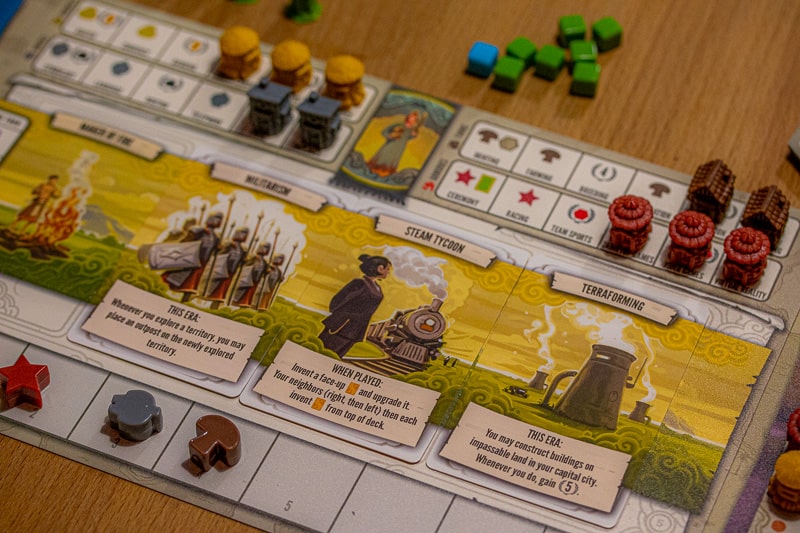
Outstanding components
One thing I can’t say about Tapestry: that it lacks production quality. Stonemaier Games shows with Tapestry which game components you can put into a normal board game. As with Wingspan, the paper of the components in Tapestry is again of very good quality. Additionally, player tableaus, civilization overviews and the capital city tableaus are extra coated, which gives the tableaus a rougher surface. Advantage: This keeps the other components in place and prevents them from slipping around unintentionally.
But the painted landmarks are of course the most eye-catching. But playfully they are rather obstructive. I use these landmarks to populate my capital. This way I get further resources, which are relatively rare and serve as payment for my actions. But I also get victory points, which are paid to me during the income phase, if I manage to fill in rows and columns completely. However, the building of the tableaus is at the expense of visibility. Again and again I look at my tableau from above to make sure I don’t miss anything. The big hand-painted landmarks take the overview from time to time.
Nor do I understand why the landmarks with their base are not aligned with the grid on the capital tableau. Yes, I am aware that this makes the capital look a little more organic, but it is at the expense of clarity.
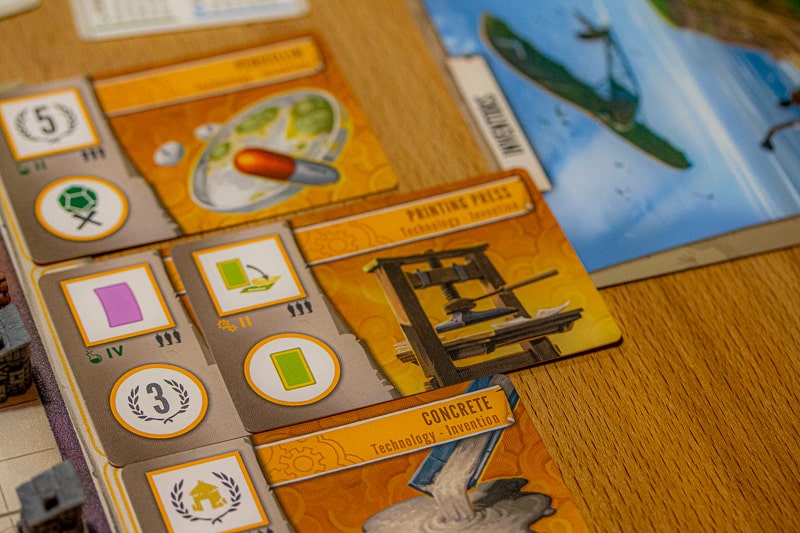
Until they are used, the landmarks are stored on an extra tableau. Through the progress tracks I have the possibility to get to three landmarks at a time. Each bar has its own colour and also the area on the house panel is identical with this colour. Why the base of the landmarks was not designed in this colour or at least the name of the building is printed on the floor is not clear to us.
Of course, I would also have used simple tiles, which I place on my tableau. But these landmarks are also a distinguishing feature of the board game and its production quality.
Nice gimmick on the side is the game board with its rounded corners. This makes for an unusual eye-catcher, because as a board player I’m rather used to square and practical game plans.
The Tapestry in Tapestry
According to Jamey Stegmeier, the name refers to the tapestries, because similar to the Middle Ages, the Tapestry cards are supposed to represent the development and important achievements on your tableau.
Of course the tapestry cards are also subject to randomness again. So it can happen that I get a card in the game that helps me more or less in the current age. The rule here is that a card is only valid for one age or gives me an instant effect when played.
For example, there is a tapestry card with which I can place any landmark from the general display on my capital city tableau. If I get this card very early in the game, it can give me a considerable boost, which in the long run brings me far ahead. However, if I get this card at the end of the game, it will do almost nothing, as most of the landmarks are already gone by then.
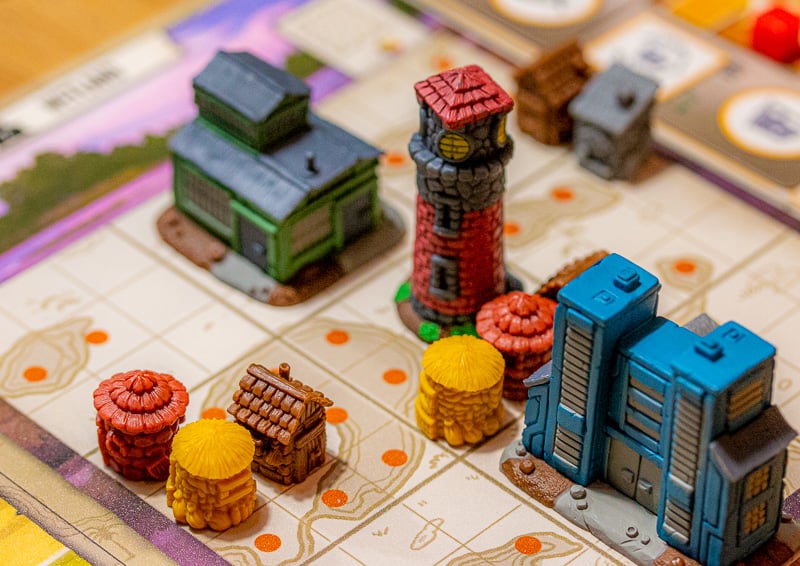
Once Civilization in Fast Pass
I think Tapestry is again a classic board game from the pen of Jamey Stegmeier. I recognize his handwriting in many details. Be it that well-known mechanisms and those favoured by him are newly interwoven with each other. Or the wish that a game should be easily accessible and that I can start playing quickly without having to explain and learn the rules in advance, but there is still enough replay appeal and variance.
Yeah, Tapestry has its quirks. Of course, it’s not a CIV game to me, but I’ve already written that. And also the overproduction didn’t have to be and the high price that goes with it. But still, Tapestry is always fun for me. Especially when I play it with people who know the rules, it’s a fast and easy game that demands enough decisions from me.
Of course there is, typical for Stonemaier Games, again a very high luck factor. Of course it’s frustrating when luck doesn’t serve you well and I lose a game because of it. But here the relationship between luck and time is correct: If Tapestry would take a little longer, it would be a strong negative point. But this is not so. It’s over too quickly for me to get really angry about it. I’d rather quickly reset the game and play another rematch.
And since the game offers enough variance, each game is played differently, not least because of the 16 different asymmetric civilizations. But the eponymous tapestry cards also force me to start each new game differently. Just because a particular tapestry card worked in the last game, it can do the exact opposite in a new game.
At the moment I like to play it again and again, even if there are enough other games waiting to be played.
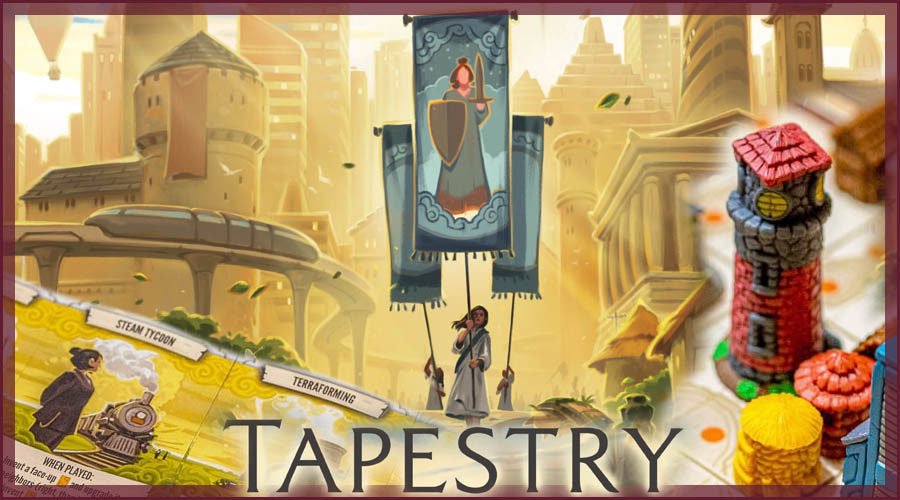
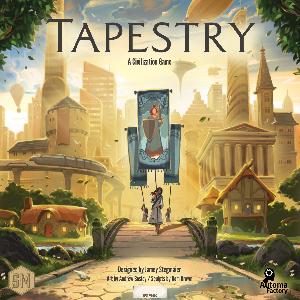
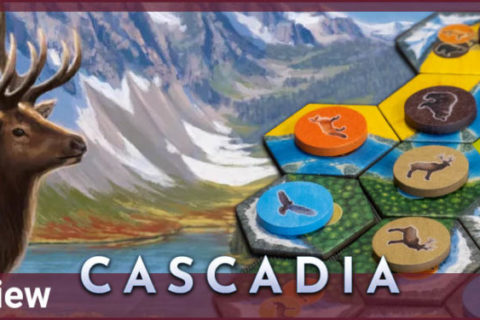
Leave a Reply